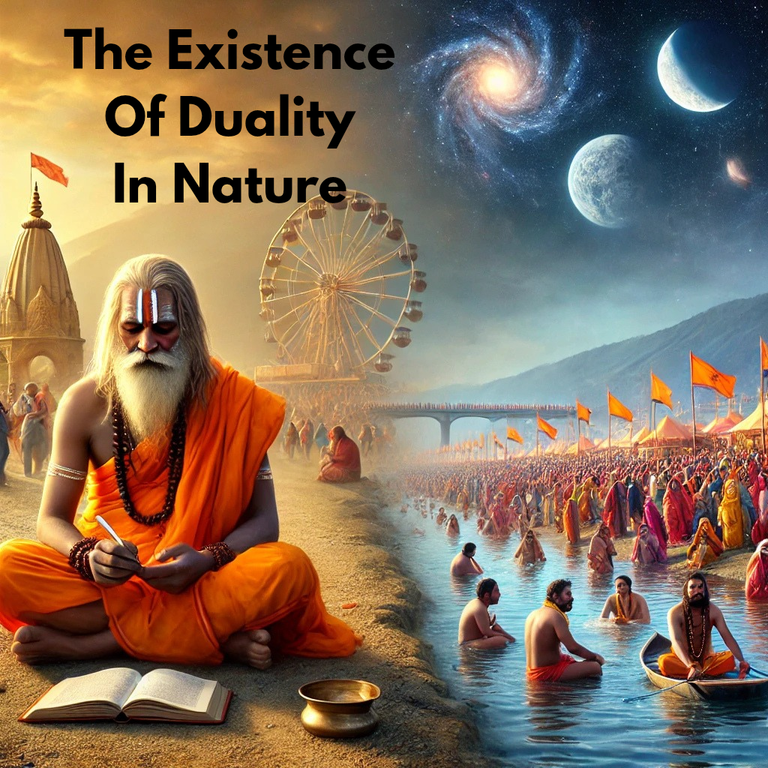Hey Everyone!!
In the midst of the grand Maha Kumbh Mela, where millions gather for spiritual enlightenment, one unusual figure has captured the attention of many. A man dressed as a saint, later identified as a graduate from IIT Bombay’s Aerospace Engineering program, became famous as “IIT Baba.” His journey from a top engineering institution to a life of spirituality and solitude has intrigued people across the nation.

Source: Canvas Dream Lab
As reports about his past surfaced, curiosity about his transformation grew. Some saw him as a man who lost his way due to personal struggles, including depression, while others recognized him as a thinker with profound insights into life and the universe. Regardless of opinions, what makes IIT Baba truly fascinating is the wisdom he shares, especially his unique theories derived from observing nature.
The Theory of Duality
One of his most thought-provoking ideas is the Theory of Duality. According to IIT Baba, everything in nature exists in pairs, and these opposing forces complete each other. He believes that nothing can exist independently without its counterpart. For example, day cannot be recognized as ‘day’ without the existence of night. Similarly, there is no concept of a mother without a child, and no light without darkness.
This idea suggests that our brain understands the world by comparing one thing with another. We create distinctions by drawing lines, placing one aspect on one side and its opposite on the other. This natural contrast helps us comprehend life’s balance and interdependence.
IIT Baba expands his theory beyond simple opposites. He argues that duality is not just about contrasting pairs but also about coexistence. He believes that happiness and sadness, strength and weakness, creation and destruction are not separate but interconnected. One cannot be understood without the other. Life, according to him, is a continuous interplay between these dual elements.
He also connects this idea to human perception and consciousness. He suggests that our understanding is shaped by how we categorize and separate things. However, he challenges this notion by asking: What if these distinctions are illusions? What if everything exists as one unified reality, but we perceive it as dual because of our limited understanding?

IIT Baba’s understanding of nature and science goes beyond conventional learning. He carries a small notebook in which he writes his observations, linking scientific concepts to spiritual wisdom. His theories attempt to bridge the gap between logic and faith, showing how the physical world connects with a deeper, unseen reality.
Listening to him speak makes one question many aspects of life. Is our understanding of the world limited by the boundaries we create in our minds? Do we truly grasp the essence of things, or do we only see them in relation to their opposites? His words force us to think beyond conventional knowledge and explore the hidden truths of existence.

Many people have different perspectives on IIT Baba. Some consider him eccentric, while others admire his intelligence and insight. However, one thing is clear—he possesses a deep knowledge that deserves further exploration. If he finds the right person who shares his curiosity and ability to understand complex ideas, his theories could be developed further.
In today’s world, where people often chase material success, IIT Baba’s story reminds us that knowledge and wisdom are not limited to institutions. True understanding can come from deep observation, reflection, and an open mind. Whether one agrees with his thoughts or not, his journey and ideas make us reflect on our own perceptions of life and reality.
Perhaps, in our pursuit of success and knowledge, we should also seek a balance—just as his Theory of Duality suggests.

TᕼᗩᑎK YOᑌ😊
ꜰᴏʀ ᴛᴀᴋɪɴɢ ᴛʜᴇ ᴛɪᴍᴇ ᴛᴏ ʀᴇᴀᴅ ᴍʏ ʙʟᴏɢꜱ!
ʜᴀᴠᴇ ᴀ ᴡᴏɴᴅᴇʀꜰᴜʟ ᴅᴀʏ🌞
